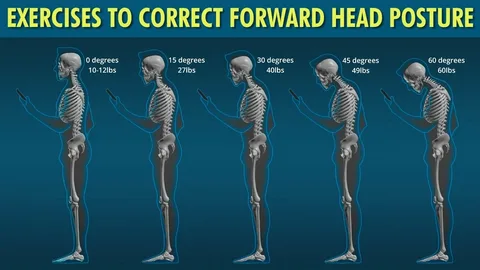Forward head posture, also known as “text neck” or “tech neck,” is a common issue caused by poor posture habits, especially from extended time spent looking down at screens. Over time, this can lead to neck pain, headaches, and even long-term spinal problems. Fortunately, with consistent effort and the right strategies, you can correct forward head posture fast. This guide will provide you with four effective steps to regain proper posture.
Understanding Forward Head Posture and Its Effects
Forward head posture occurs when the head juts forward beyond the body’s natural alignment, putting strain on the neck and upper back muscles. Normally, the head should be positioned directly above the spine, allowing for even distribution of weight. However, with forward head posture, the weight of the head creates additional pressure on the cervical spine, leading to muscle fatigue, joint pain, and even damage to the surrounding tissues.
The effects of forward head posture go beyond aesthetics. If left untreated, it can cause chronic pain, reduce flexibility, and even interfere with daily activities. The longer it persists, the more challenging it becomes to correct. Understanding the root cause is essential for effective treatment. Whether it’s caused by prolonged sitting, poor posture at a desk, or excessive phone use, knowing the source of your forward head posture can help you target the right corrective measures.
Strengthening Neck and Upper Back Muscles
One of the most effective ways to correct forward head posture is by strengthening the muscles that support your neck and upper back. These muscles are often weakened or overstretched due to poor posture habits. Specific exercises can help strengthen and stabilize these areas, allowing your head and neck to return to a neutral position.
Start by incorporating chin tucks into your routine. To do this, gently pull your head back so that your ears align with your shoulders. Hold for a few seconds, then release. This exercise strengthens the deep neck flexors, which play a critical role in maintaining proper posture. Additionally, performing rows with resistance bands or weights can help strengthen the upper back muscles, which are crucial for pulling your shoulders back and supporting your head.
Consistency is key when it comes to building strength. Performing these exercises a few times a day, especially after periods of sitting or looking down at a screen, can significantly speed up your progress. Over time, you’ll notice your neck muscles becoming stronger and your head naturally returning to a better position.
Improving Posture Awareness and Ergonomics
Another essential step in fixing forward head posture is improving your posture awareness and optimizing your work or home environment. Many people develop forward head posture due to long hours spent at desks or using electronic devices in poor ergonomic conditions. Adjusting your workspace can make a substantial difference in how fast you see results.
Start by ensuring your computer screen is at eye level, which prevents you from constantly looking down. Your shoulders should be relaxed, and your back supported by a chair with lumbar support. If you use a phone frequently, consider using a phone holder or holding it at eye level to avoid bending your neck forward. Small changes in how you position your body during daily tasks can have a major impact on correcting forward head posture.
Additionally, becoming more aware of your posture throughout the day can help you make quick corrections. Set reminders on your phone or computer to check your posture every hour. Over time, maintaining better posture will become second nature, helping to correct forward head posture more quickly.
Stretching and Mobility Work to Relieve Tension
Forward head posture often causes tightness in the neck and chest muscles. Stretching these areas can relieve tension, improve flexibility, and help correct the imbalance caused by poor posture. Adding mobility work to your routine is crucial for fast progress.
Focus on stretches that target the neck, shoulders, and chest. A simple neck stretch involves tilting your head to one side and holding it for 20-30 seconds before switching sides. This helps to release tight muscles and increase mobility. You can also incorporate chest stretches, such as placing your arm against a wall and gently turning your body away from it to stretch the pectoral muscles. This helps open up the chest, counteracting the hunched-forward position often seen in forward head posture.
Along with stretching, incorporating foam rolling or massage techniques can help break up muscle tension and improve blood flow to the affected areas. Regular mobility work not only reduces discomfort but also allows your muscles to relax and adapt to a new, healthier position.
Conclusion
Fixing forward head posture quickly requires a combination of strengthening, posture awareness, ergonomic adjustments, and stretching. By incorporating these strategies into your daily routine, you can correct poor posture habits and prevent long-term damage to your neck and spine. Remember that consistency is key—perform exercises regularly, remain mindful of your posture, and make adjustments to your work and home environments for optimal results. In time, you’ll notice an improvement in both your posture and overall comfort.how to fix forward head posture
